In-depth Case Study: Psychodynamic Therapy for BPD Client
VerifiedAdded on 2023/06/07
|55
|16268
|205
Case Study
AI Summary
This case study explores the application of psychodynamic therapy to address the complex needs of a 42-year-old client, Jane, diagnosed with Borderline Personality Disorder (BPD) and a history of substance abuse. The therapeutic relationship began at H.I.M.H, a charity organization supporting individuals from diverse ethnic backgrounds who are victims of human trafficking, domestic violence, and chronic mental health issues. The study details Jane's presentation, including her outward appearance, communication challenges related to an undiagnosed learning disability, and difficulties maintaining eye contact. It outlines her referral history, presenting problems such as multiple sexual relationships, and a detailed family history marked by trauma, including physical abuse and abandonment. The formulation section likely delves into the theoretical underpinnings of the chosen psychodynamic approach, the establishment of a therapeutic contract, and the setting of therapeutic objectives. Extracts from therapy sessions may illustrate the therapeutic process, and the study concludes with an analysis of outcomes, including countertransference issues and achieved goals. The document is a student contribution and available on Desklib, a platform providing study tools and resources.
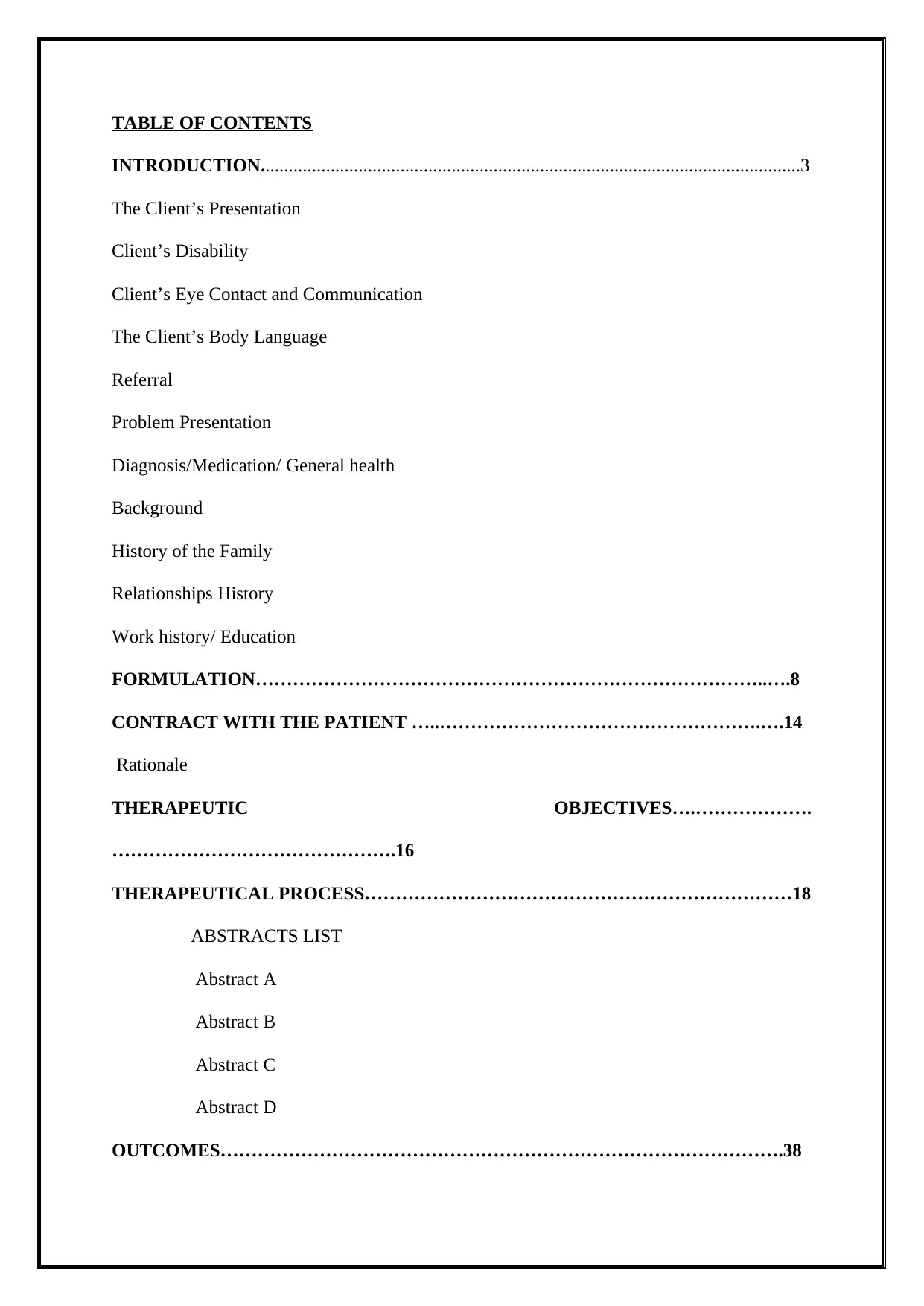
TABLE OF CONTENTS
INTRODUCTION....................................................................................................................3
The Client’s Presentation
Client’s Disability
Client’s Eye Contact and Communication
The Client’s Body Language
Referral
Problem Presentation
Diagnosis/Medication/ General health
Background
History of the Family
Relationships History
Work history/ Education
FORMULATION………………………………………………………………………..….8
CONTRACT WITH THE PATIENT …..…………………………………………….….14
Rationale
THERAPEUTIC OBJECTIVES….……………….
……………………………………….16
THERAPEUTICAL PROCESS……………………………………………………………18
ABSTRACTS LIST
Abstract A
Abstract B
Abstract C
Abstract D
OUTCOMES……………………………………………………………………………….38
INTRODUCTION....................................................................................................................3
The Client’s Presentation
Client’s Disability
Client’s Eye Contact and Communication
The Client’s Body Language
Referral
Problem Presentation
Diagnosis/Medication/ General health
Background
History of the Family
Relationships History
Work history/ Education
FORMULATION………………………………………………………………………..….8
CONTRACT WITH THE PATIENT …..…………………………………………….….14
Rationale
THERAPEUTIC OBJECTIVES….……………….
……………………………………….16
THERAPEUTICAL PROCESS……………………………………………………………18
ABSTRACTS LIST
Abstract A
Abstract B
Abstract C
Abstract D
OUTCOMES……………………………………………………………………………….38
Paraphrase This Document
Need a fresh take? Get an instant paraphrase of this document with our AI Paraphraser

Counter transference
OBJECTIVES
REFERENCE ………………………………………………………………………51
I
2
OBJECTIVES
REFERENCE ………………………………………………………………………51
I
2
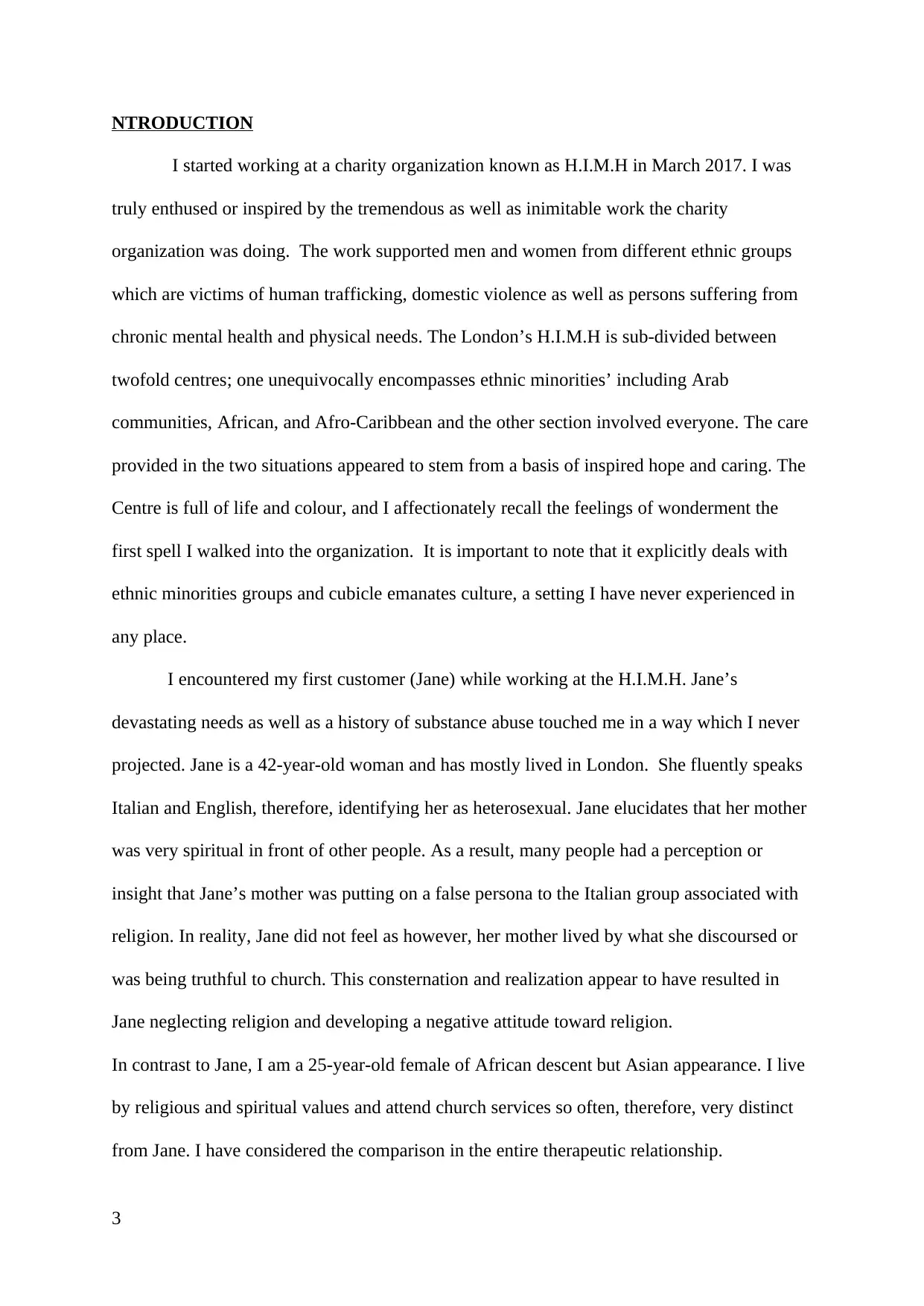
NTRODUCTION
I started working at a charity organization known as H.I.M.H in March 2017. I was
truly enthused or inspired by the tremendous as well as inimitable work the charity
organization was doing. The work supported men and women from different ethnic groups
which are victims of human trafficking, domestic violence as well as persons suffering from
chronic mental health and physical needs. The London’s H.I.M.H is sub-divided between
twofold centres; one unequivocally encompasses ethnic minorities’ including Arab
communities, African, and Afro-Caribbean and the other section involved everyone. The care
provided in the two situations appeared to stem from a basis of inspired hope and caring. The
Centre is full of life and colour, and I affectionately recall the feelings of wonderment the
first spell I walked into the organization. It is important to note that it explicitly deals with
ethnic minorities groups and cubicle emanates culture, a setting I have never experienced in
any place.
I encountered my first customer (Jane) while working at the H.I.M.H. Jane’s
devastating needs as well as a history of substance abuse touched me in a way which I never
projected. Jane is a 42-year-old woman and has mostly lived in London. She fluently speaks
Italian and English, therefore, identifying her as heterosexual. Jane elucidates that her mother
was very spiritual in front of other people. As a result, many people had a perception or
insight that Jane’s mother was putting on a false persona to the Italian group associated with
religion. In reality, Jane did not feel as however, her mother lived by what she discoursed or
was being truthful to church. This consternation and realization appear to have resulted in
Jane neglecting religion and developing a negative attitude toward religion.
In contrast to Jane, I am a 25-year-old female of African descent but Asian appearance. I live
by religious and spiritual values and attend church services so often, therefore, very distinct
from Jane. I have considered the comparison in the entire therapeutic relationship.
3
I started working at a charity organization known as H.I.M.H in March 2017. I was
truly enthused or inspired by the tremendous as well as inimitable work the charity
organization was doing. The work supported men and women from different ethnic groups
which are victims of human trafficking, domestic violence as well as persons suffering from
chronic mental health and physical needs. The London’s H.I.M.H is sub-divided between
twofold centres; one unequivocally encompasses ethnic minorities’ including Arab
communities, African, and Afro-Caribbean and the other section involved everyone. The care
provided in the two situations appeared to stem from a basis of inspired hope and caring. The
Centre is full of life and colour, and I affectionately recall the feelings of wonderment the
first spell I walked into the organization. It is important to note that it explicitly deals with
ethnic minorities groups and cubicle emanates culture, a setting I have never experienced in
any place.
I encountered my first customer (Jane) while working at the H.I.M.H. Jane’s
devastating needs as well as a history of substance abuse touched me in a way which I never
projected. Jane is a 42-year-old woman and has mostly lived in London. She fluently speaks
Italian and English, therefore, identifying her as heterosexual. Jane elucidates that her mother
was very spiritual in front of other people. As a result, many people had a perception or
insight that Jane’s mother was putting on a false persona to the Italian group associated with
religion. In reality, Jane did not feel as however, her mother lived by what she discoursed or
was being truthful to church. This consternation and realization appear to have resulted in
Jane neglecting religion and developing a negative attitude toward religion.
In contrast to Jane, I am a 25-year-old female of African descent but Asian appearance. I live
by religious and spiritual values and attend church services so often, therefore, very distinct
from Jane. I have considered the comparison in the entire therapeutic relationship.
3
⊘ This is a preview!⊘
Do you want full access?
Subscribe today to unlock all pages.

Trusted by 1+ million students worldwide
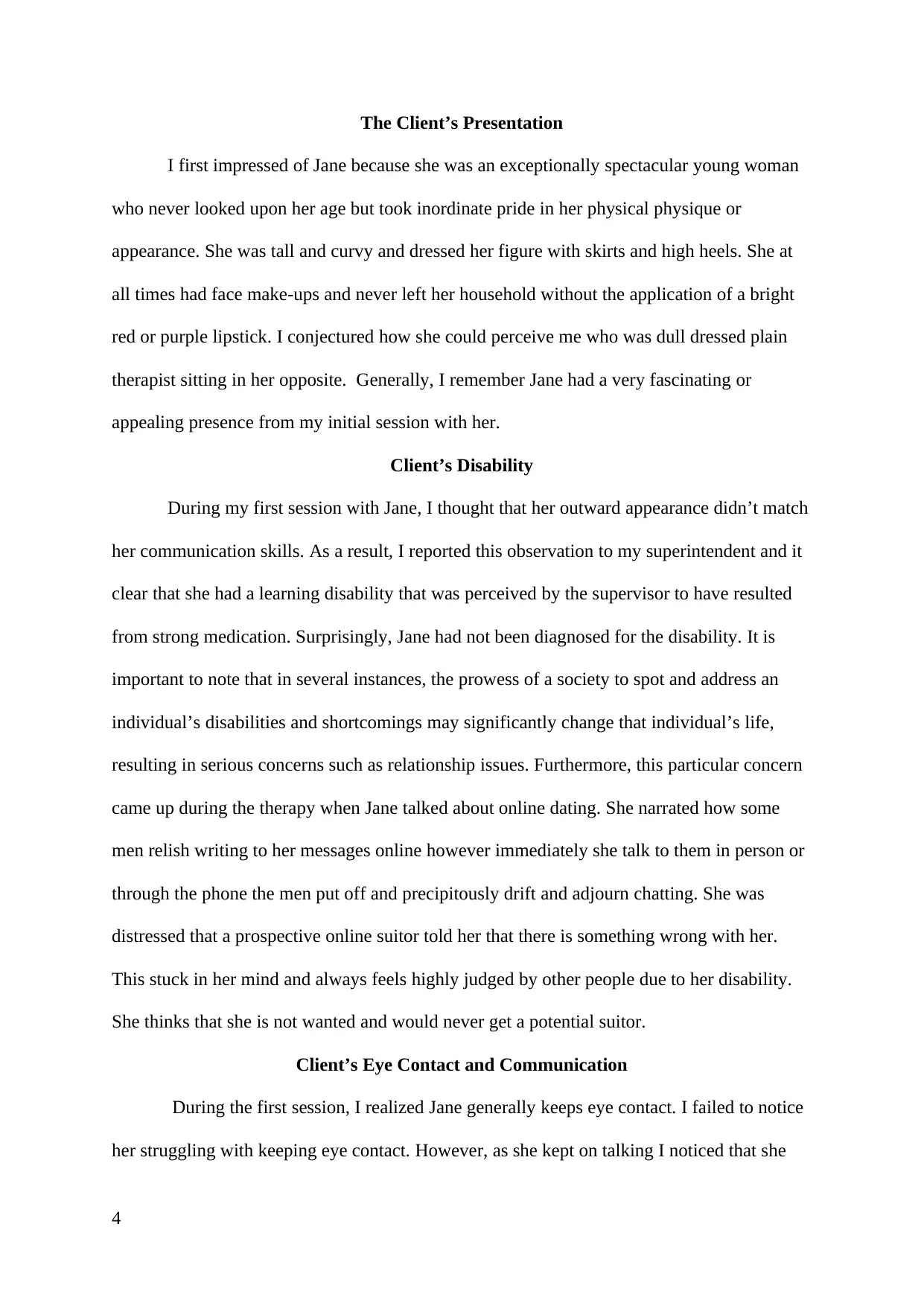
The Client’s Presentation
I first impressed of Jane because she was an exceptionally spectacular young woman
who never looked upon her age but took inordinate pride in her physical physique or
appearance. She was tall and curvy and dressed her figure with skirts and high heels. She at
all times had face make-ups and never left her household without the application of a bright
red or purple lipstick. I conjectured how she could perceive me who was dull dressed plain
therapist sitting in her opposite. Generally, I remember Jane had a very fascinating or
appealing presence from my initial session with her.
Client’s Disability
During my first session with Jane, I thought that her outward appearance didn’t match
her communication skills. As a result, I reported this observation to my superintendent and it
clear that she had a learning disability that was perceived by the supervisor to have resulted
from strong medication. Surprisingly, Jane had not been diagnosed for the disability. It is
important to note that in several instances, the prowess of a society to spot and address an
individual’s disabilities and shortcomings may significantly change that individual’s life,
resulting in serious concerns such as relationship issues. Furthermore, this particular concern
came up during the therapy when Jane talked about online dating. She narrated how some
men relish writing to her messages online however immediately she talk to them in person or
through the phone the men put off and precipitously drift and adjourn chatting. She was
distressed that a prospective online suitor told her that there is something wrong with her.
This stuck in her mind and always feels highly judged by other people due to her disability.
She thinks that she is not wanted and would never get a potential suitor.
Client’s Eye Contact and Communication
During the first session, I realized Jane generally keeps eye contact. I failed to notice
her struggling with keeping eye contact. However, as she kept on talking I noticed that she
4
I first impressed of Jane because she was an exceptionally spectacular young woman
who never looked upon her age but took inordinate pride in her physical physique or
appearance. She was tall and curvy and dressed her figure with skirts and high heels. She at
all times had face make-ups and never left her household without the application of a bright
red or purple lipstick. I conjectured how she could perceive me who was dull dressed plain
therapist sitting in her opposite. Generally, I remember Jane had a very fascinating or
appealing presence from my initial session with her.
Client’s Disability
During my first session with Jane, I thought that her outward appearance didn’t match
her communication skills. As a result, I reported this observation to my superintendent and it
clear that she had a learning disability that was perceived by the supervisor to have resulted
from strong medication. Surprisingly, Jane had not been diagnosed for the disability. It is
important to note that in several instances, the prowess of a society to spot and address an
individual’s disabilities and shortcomings may significantly change that individual’s life,
resulting in serious concerns such as relationship issues. Furthermore, this particular concern
came up during the therapy when Jane talked about online dating. She narrated how some
men relish writing to her messages online however immediately she talk to them in person or
through the phone the men put off and precipitously drift and adjourn chatting. She was
distressed that a prospective online suitor told her that there is something wrong with her.
This stuck in her mind and always feels highly judged by other people due to her disability.
She thinks that she is not wanted and would never get a potential suitor.
Client’s Eye Contact and Communication
During the first session, I realized Jane generally keeps eye contact. I failed to notice
her struggling with keeping eye contact. However, as she kept on talking I noticed that she
4
Paraphrase This Document
Need a fresh take? Get an instant paraphrase of this document with our AI Paraphraser
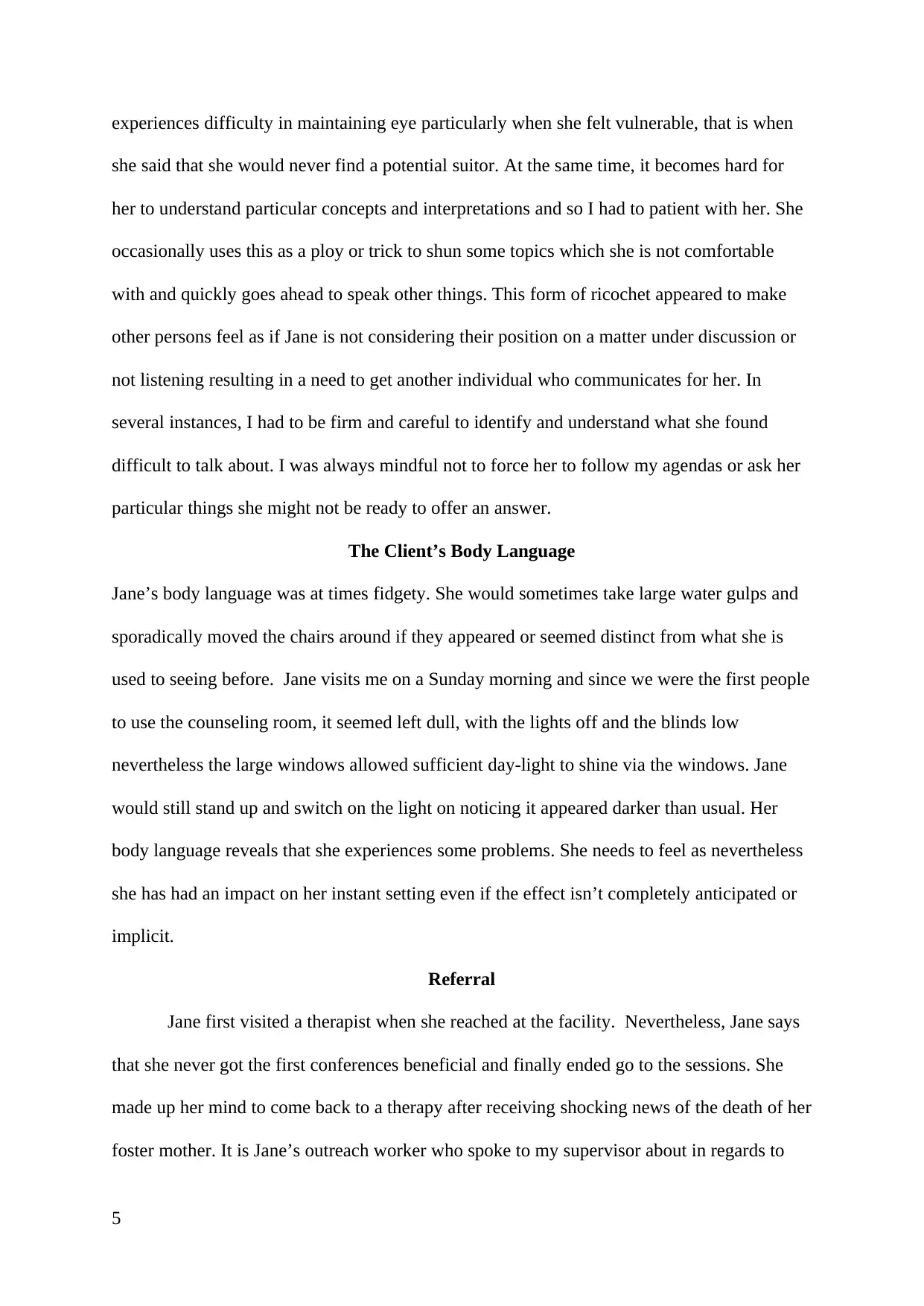
experiences difficulty in maintaining eye particularly when she felt vulnerable, that is when
she said that she would never find a potential suitor. At the same time, it becomes hard for
her to understand particular concepts and interpretations and so I had to patient with her. She
occasionally uses this as a ploy or trick to shun some topics which she is not comfortable
with and quickly goes ahead to speak other things. This form of ricochet appeared to make
other persons feel as if Jane is not considering their position on a matter under discussion or
not listening resulting in a need to get another individual who communicates for her. In
several instances, I had to be firm and careful to identify and understand what she found
difficult to talk about. I was always mindful not to force her to follow my agendas or ask her
particular things she might not be ready to offer an answer.
The Client’s Body Language
Jane’s body language was at times fidgety. She would sometimes take large water gulps and
sporadically moved the chairs around if they appeared or seemed distinct from what she is
used to seeing before. Jane visits me on a Sunday morning and since we were the first people
to use the counseling room, it seemed left dull, with the lights off and the blinds low
nevertheless the large windows allowed sufficient day-light to shine via the windows. Jane
would still stand up and switch on the light on noticing it appeared darker than usual. Her
body language reveals that she experiences some problems. She needs to feel as nevertheless
she has had an impact on her instant setting even if the effect isn’t completely anticipated or
implicit.
Referral
Jane first visited a therapist when she reached at the facility. Nevertheless, Jane says
that she never got the first conferences beneficial and finally ended go to the sessions. She
made up her mind to come back to a therapy after receiving shocking news of the death of her
foster mother. It is Jane’s outreach worker who spoke to my supervisor about in regards to
5
she said that she would never find a potential suitor. At the same time, it becomes hard for
her to understand particular concepts and interpretations and so I had to patient with her. She
occasionally uses this as a ploy or trick to shun some topics which she is not comfortable
with and quickly goes ahead to speak other things. This form of ricochet appeared to make
other persons feel as if Jane is not considering their position on a matter under discussion or
not listening resulting in a need to get another individual who communicates for her. In
several instances, I had to be firm and careful to identify and understand what she found
difficult to talk about. I was always mindful not to force her to follow my agendas or ask her
particular things she might not be ready to offer an answer.
The Client’s Body Language
Jane’s body language was at times fidgety. She would sometimes take large water gulps and
sporadically moved the chairs around if they appeared or seemed distinct from what she is
used to seeing before. Jane visits me on a Sunday morning and since we were the first people
to use the counseling room, it seemed left dull, with the lights off and the blinds low
nevertheless the large windows allowed sufficient day-light to shine via the windows. Jane
would still stand up and switch on the light on noticing it appeared darker than usual. Her
body language reveals that she experiences some problems. She needs to feel as nevertheless
she has had an impact on her instant setting even if the effect isn’t completely anticipated or
implicit.
Referral
Jane first visited a therapist when she reached at the facility. Nevertheless, Jane says
that she never got the first conferences beneficial and finally ended go to the sessions. She
made up her mind to come back to a therapy after receiving shocking news of the death of her
foster mother. It is Jane’s outreach worker who spoke to my supervisor about in regards to
5
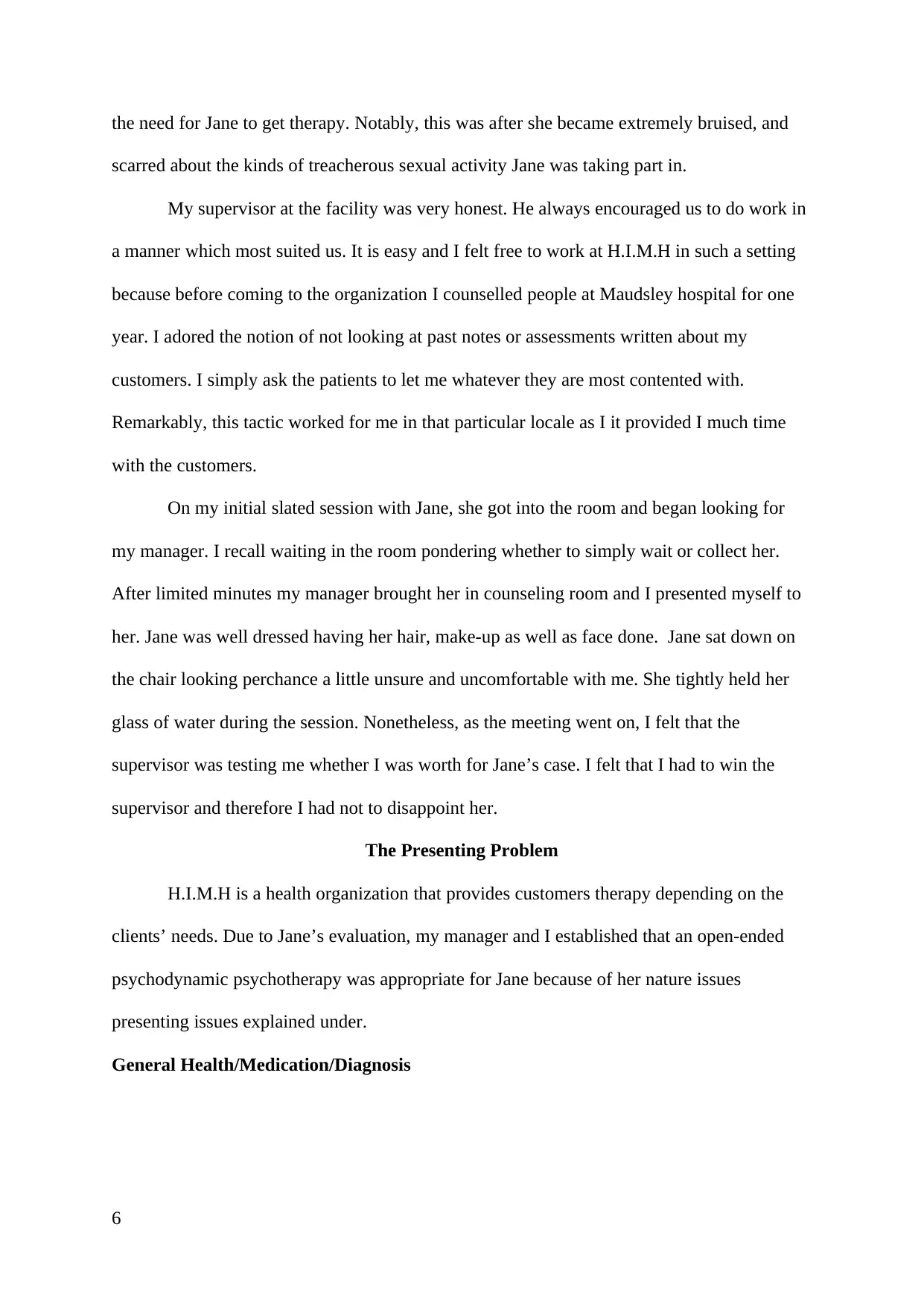
the need for Jane to get therapy. Notably, this was after she became extremely bruised, and
scarred about the kinds of treacherous sexual activity Jane was taking part in.
My supervisor at the facility was very honest. He always encouraged us to do work in
a manner which most suited us. It is easy and I felt free to work at H.I.M.H in such a setting
because before coming to the organization I counselled people at Maudsley hospital for one
year. I adored the notion of not looking at past notes or assessments written about my
customers. I simply ask the patients to let me whatever they are most contented with.
Remarkably, this tactic worked for me in that particular locale as I it provided I much time
with the customers.
On my initial slated session with Jane, she got into the room and began looking for
my manager. I recall waiting in the room pondering whether to simply wait or collect her.
After limited minutes my manager brought her in counseling room and I presented myself to
her. Jane was well dressed having her hair, make-up as well as face done. Jane sat down on
the chair looking perchance a little unsure and uncomfortable with me. She tightly held her
glass of water during the session. Nonetheless, as the meeting went on, I felt that the
supervisor was testing me whether I was worth for Jane’s case. I felt that I had to win the
supervisor and therefore I had not to disappoint her.
The Presenting Problem
H.I.M.H is a health organization that provides customers therapy depending on the
clients’ needs. Due to Jane’s evaluation, my manager and I established that an open-ended
psychodynamic psychotherapy was appropriate for Jane because of her nature issues
presenting issues explained under.
General Health/Medication/Diagnosis
6
scarred about the kinds of treacherous sexual activity Jane was taking part in.
My supervisor at the facility was very honest. He always encouraged us to do work in
a manner which most suited us. It is easy and I felt free to work at H.I.M.H in such a setting
because before coming to the organization I counselled people at Maudsley hospital for one
year. I adored the notion of not looking at past notes or assessments written about my
customers. I simply ask the patients to let me whatever they are most contented with.
Remarkably, this tactic worked for me in that particular locale as I it provided I much time
with the customers.
On my initial slated session with Jane, she got into the room and began looking for
my manager. I recall waiting in the room pondering whether to simply wait or collect her.
After limited minutes my manager brought her in counseling room and I presented myself to
her. Jane was well dressed having her hair, make-up as well as face done. Jane sat down on
the chair looking perchance a little unsure and uncomfortable with me. She tightly held her
glass of water during the session. Nonetheless, as the meeting went on, I felt that the
supervisor was testing me whether I was worth for Jane’s case. I felt that I had to win the
supervisor and therefore I had not to disappoint her.
The Presenting Problem
H.I.M.H is a health organization that provides customers therapy depending on the
clients’ needs. Due to Jane’s evaluation, my manager and I established that an open-ended
psychodynamic psychotherapy was appropriate for Jane because of her nature issues
presenting issues explained under.
General Health/Medication/Diagnosis
6
⊘ This is a preview!⊘
Do you want full access?
Subscribe today to unlock all pages.

Trusted by 1+ million students worldwide
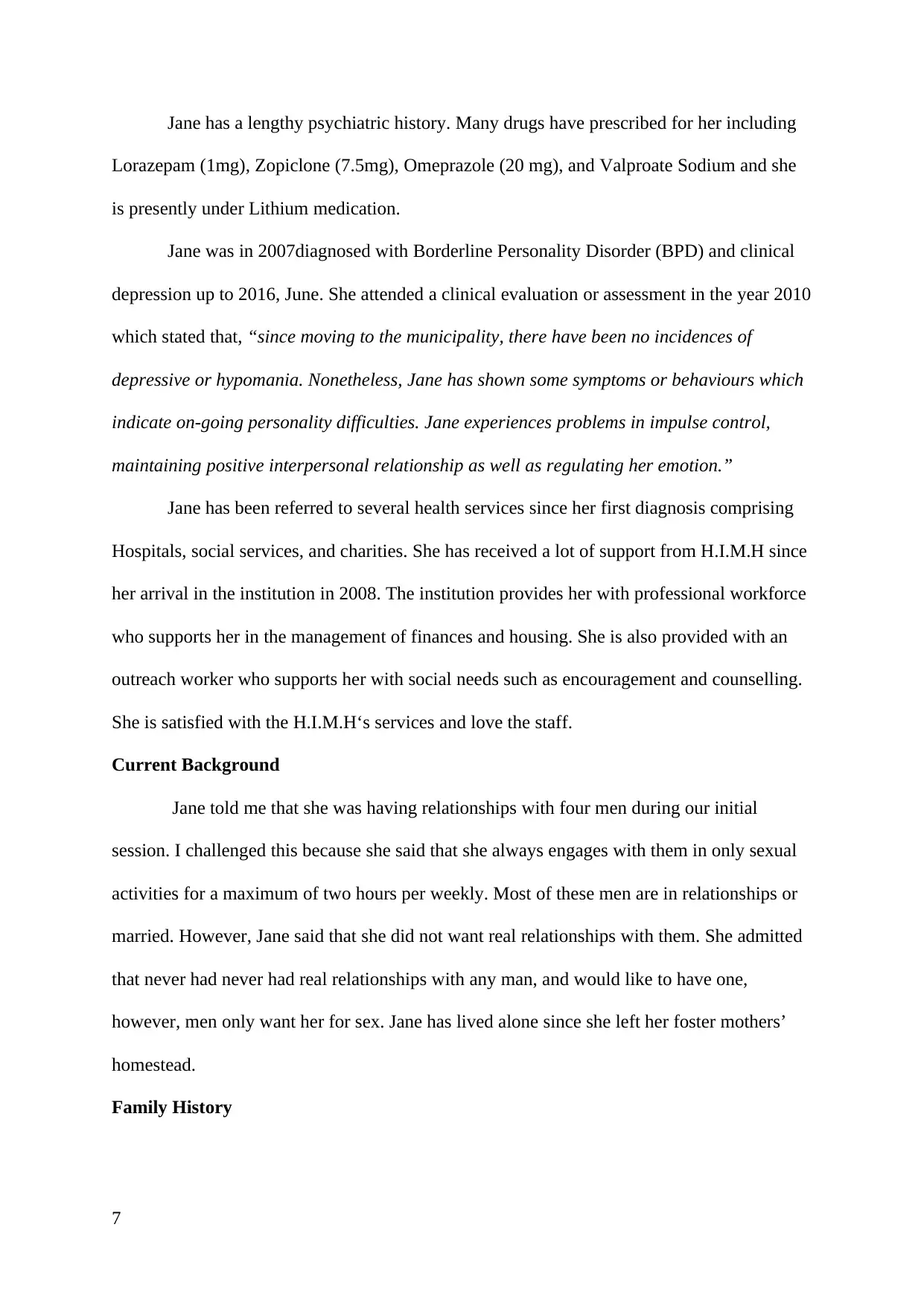
Jane has a lengthy psychiatric history. Many drugs have prescribed for her including
Lorazepam (1mg), Zopiclone (7.5mg), Omeprazole (20 mg), and Valproate Sodium and she
is presently under Lithium medication.
Jane was in 2007diagnosed with Borderline Personality Disorder (BPD) and clinical
depression up to 2016, June. She attended a clinical evaluation or assessment in the year 2010
which stated that, “since moving to the municipality, there have been no incidences of
depressive or hypomania. Nonetheless, Jane has shown some symptoms or behaviours which
indicate on-going personality difficulties. Jane experiences problems in impulse control,
maintaining positive interpersonal relationship as well as regulating her emotion.”
Jane has been referred to several health services since her first diagnosis comprising
Hospitals, social services, and charities. She has received a lot of support from H.I.M.H since
her arrival in the institution in 2008. The institution provides her with professional workforce
who supports her in the management of finances and housing. She is also provided with an
outreach worker who supports her with social needs such as encouragement and counselling.
She is satisfied with the H.I.M.H‘s services and love the staff.
Current Background
Jane told me that she was having relationships with four men during our initial
session. I challenged this because she said that she always engages with them in only sexual
activities for a maximum of two hours per weekly. Most of these men are in relationships or
married. However, Jane said that she did not want real relationships with them. She admitted
that never had never had real relationships with any man, and would like to have one,
however, men only want her for sex. Jane has lived alone since she left her foster mothers’
homestead.
Family History
7
Lorazepam (1mg), Zopiclone (7.5mg), Omeprazole (20 mg), and Valproate Sodium and she
is presently under Lithium medication.
Jane was in 2007diagnosed with Borderline Personality Disorder (BPD) and clinical
depression up to 2016, June. She attended a clinical evaluation or assessment in the year 2010
which stated that, “since moving to the municipality, there have been no incidences of
depressive or hypomania. Nonetheless, Jane has shown some symptoms or behaviours which
indicate on-going personality difficulties. Jane experiences problems in impulse control,
maintaining positive interpersonal relationship as well as regulating her emotion.”
Jane has been referred to several health services since her first diagnosis comprising
Hospitals, social services, and charities. She has received a lot of support from H.I.M.H since
her arrival in the institution in 2008. The institution provides her with professional workforce
who supports her in the management of finances and housing. She is also provided with an
outreach worker who supports her with social needs such as encouragement and counselling.
She is satisfied with the H.I.M.H‘s services and love the staff.
Current Background
Jane told me that she was having relationships with four men during our initial
session. I challenged this because she said that she always engages with them in only sexual
activities for a maximum of two hours per weekly. Most of these men are in relationships or
married. However, Jane said that she did not want real relationships with them. She admitted
that never had never had real relationships with any man, and would like to have one,
however, men only want her for sex. Jane has lived alone since she left her foster mothers’
homestead.
Family History
7
Paraphrase This Document
Need a fresh take? Get an instant paraphrase of this document with our AI Paraphraser

Jane comes from a large family; however, it was hard to understand what part of the
family she meant. Jane made a drawing of a family-tree on a paper during the session. This
was enormously helpful to me.
Jane’s father divorced her mother before she was born. As such, she had not seen the
father until she was 15 years old. After the divorce, Jane’s mother got into another
relationship and gave birth to two children; a girl and a boy. Jane was physically raped by the
stepfather and due to that ran away from her mother. She joined foster carer at 13 years. The
foster mother took care of her until she was18 years after which got her own residence while
studying. Jane flew to the U.S. at 16 years to meet her father for the very first time. Jane
found that the biological father had entered into a second relationship and had sired two
children.
The biological father didn’t want to know her and admitted he was embarrassed to
refer to her as his biological daughter due to her disability and outlook. She came back to
London and got another chance to meet her biological father once more due to her thirties.
She tried to maintain a relationship with him however the father was not interested, making
her give up.
Jane never mentioned her mother until a few weeks into therapy. It seemed hard for her to
talk about her relationship with the mother. She noticed that the mother never thought of her
even after the father’s open abandonment. The mother currently resides in Italy with her
stepfather and she sometimes visits. She says that she hardly visits her because she found it
difficult to deal with her mother due to her anger.
Relationship History
Jane has a history of men who she slept with. She says that her initial boyfriend at the
age of 19 was very obnoxious and would sometimes sexually assault her. She had several
foul relationships and her behavior tended to get her out of one and hand her over to another
8
family she meant. Jane made a drawing of a family-tree on a paper during the session. This
was enormously helpful to me.
Jane’s father divorced her mother before she was born. As such, she had not seen the
father until she was 15 years old. After the divorce, Jane’s mother got into another
relationship and gave birth to two children; a girl and a boy. Jane was physically raped by the
stepfather and due to that ran away from her mother. She joined foster carer at 13 years. The
foster mother took care of her until she was18 years after which got her own residence while
studying. Jane flew to the U.S. at 16 years to meet her father for the very first time. Jane
found that the biological father had entered into a second relationship and had sired two
children.
The biological father didn’t want to know her and admitted he was embarrassed to
refer to her as his biological daughter due to her disability and outlook. She came back to
London and got another chance to meet her biological father once more due to her thirties.
She tried to maintain a relationship with him however the father was not interested, making
her give up.
Jane never mentioned her mother until a few weeks into therapy. It seemed hard for her to
talk about her relationship with the mother. She noticed that the mother never thought of her
even after the father’s open abandonment. The mother currently resides in Italy with her
stepfather and she sometimes visits. She says that she hardly visits her because she found it
difficult to deal with her mother due to her anger.
Relationship History
Jane has a history of men who she slept with. She says that her initial boyfriend at the
age of 19 was very obnoxious and would sometimes sexually assault her. She had several
foul relationships and her behavior tended to get her out of one and hand her over to another
8
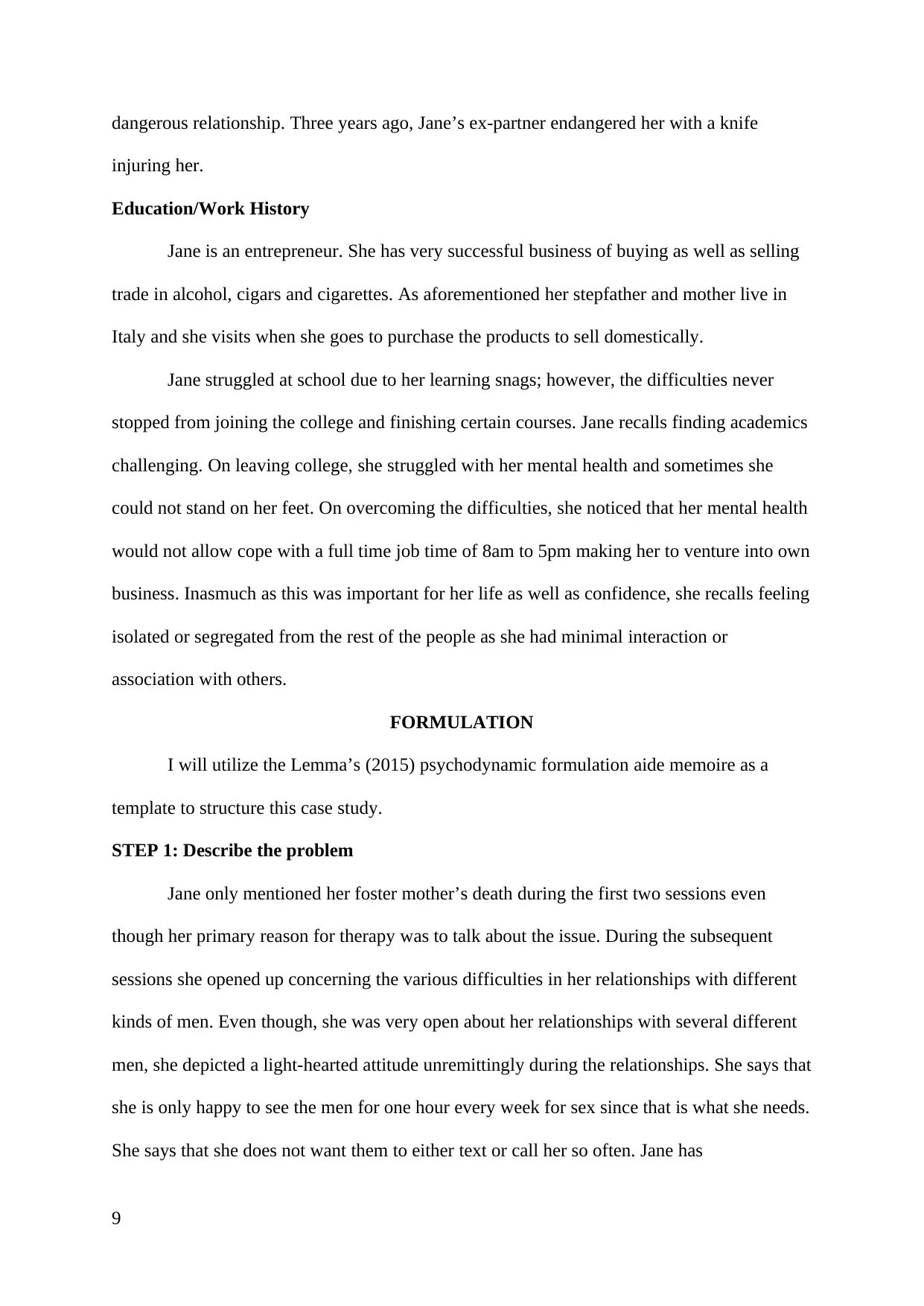
dangerous relationship. Three years ago, Jane’s ex-partner endangered her with a knife
injuring her.
Education/Work History
Jane is an entrepreneur. She has very successful business of buying as well as selling
trade in alcohol, cigars and cigarettes. As aforementioned her stepfather and mother live in
Italy and she visits when she goes to purchase the products to sell domestically.
Jane struggled at school due to her learning snags; however, the difficulties never
stopped from joining the college and finishing certain courses. Jane recalls finding academics
challenging. On leaving college, she struggled with her mental health and sometimes she
could not stand on her feet. On overcoming the difficulties, she noticed that her mental health
would not allow cope with a full time job time of 8am to 5pm making her to venture into own
business. Inasmuch as this was important for her life as well as confidence, she recalls feeling
isolated or segregated from the rest of the people as she had minimal interaction or
association with others.
FORMULATION
I will utilize the Lemma’s (2015) psychodynamic formulation aide memoire as a
template to structure this case study.
STEP 1: Describe the problem
Jane only mentioned her foster mother’s death during the first two sessions even
though her primary reason for therapy was to talk about the issue. During the subsequent
sessions she opened up concerning the various difficulties in her relationships with different
kinds of men. Even though, she was very open about her relationships with several different
men, she depicted a light-hearted attitude unremittingly during the relationships. She says that
she is only happy to see the men for one hour every week for sex since that is what she needs.
She says that she does not want them to either text or call her so often. Jane has
9
injuring her.
Education/Work History
Jane is an entrepreneur. She has very successful business of buying as well as selling
trade in alcohol, cigars and cigarettes. As aforementioned her stepfather and mother live in
Italy and she visits when she goes to purchase the products to sell domestically.
Jane struggled at school due to her learning snags; however, the difficulties never
stopped from joining the college and finishing certain courses. Jane recalls finding academics
challenging. On leaving college, she struggled with her mental health and sometimes she
could not stand on her feet. On overcoming the difficulties, she noticed that her mental health
would not allow cope with a full time job time of 8am to 5pm making her to venture into own
business. Inasmuch as this was important for her life as well as confidence, she recalls feeling
isolated or segregated from the rest of the people as she had minimal interaction or
association with others.
FORMULATION
I will utilize the Lemma’s (2015) psychodynamic formulation aide memoire as a
template to structure this case study.
STEP 1: Describe the problem
Jane only mentioned her foster mother’s death during the first two sessions even
though her primary reason for therapy was to talk about the issue. During the subsequent
sessions she opened up concerning the various difficulties in her relationships with different
kinds of men. Even though, she was very open about her relationships with several different
men, she depicted a light-hearted attitude unremittingly during the relationships. She says that
she is only happy to see the men for one hour every week for sex since that is what she needs.
She says that she does not want them to either text or call her so often. Jane has
9
⊘ This is a preview!⊘
Do you want full access?
Subscribe today to unlock all pages.

Trusted by 1+ million students worldwide

characteristics of a masochistic customer because she gets engaged in perilous sexual
activities including bondage, beating, and whipping which results in suffering and
humiliation which more often leads her excruciating pain.
Step 2: Define the cognitive costs of the problem
Jane concedes that she experiences problems in getting into more formal and healthy
relationship, although she prefers such kind of abusive relationships. Jane suffers from fear of
isolation, segregation, and loneliness and struggles with establishing boundaries with others.
She says that rather be badly treated than remain lonely.
Step 3: Contextualize the menace or problem
Jane has an ill-fated history of shock dating back to infancy. The father departed with
the kinfolk when Jane was 3 years of age. At that time Jane had no brother or sister at until
her mother re-married one year later giving birth to two children. Her biological father later
re-coupled giving birth to two daughters. Jane craved to obtain her biological father’s love
and attention but got rejected by the father several times. Jane as well had a bad relationship
with the stepfather due to her bad treatment which later resulted in her physical abuse and
psychological neglect.
At the point when Jane was only 14 years of age, she was encouraged by a solitary
parental she referred to as Grandma as she may perhaps never again live inside her family
household with the consistent manhandle as well as contending among her. Jane was
particularly annoyed that her mom didn’t once attempt to inspire her to return or get some
information in regards adaption.
Jane had a background marked by men utilizing her for sexual activities, she had
exceptionally awful relationships when she was only 17 years of age, she recalled her
accomplice being extremely regulatory and always sexually assaulting her. From that point
10
activities including bondage, beating, and whipping which results in suffering and
humiliation which more often leads her excruciating pain.
Step 2: Define the cognitive costs of the problem
Jane concedes that she experiences problems in getting into more formal and healthy
relationship, although she prefers such kind of abusive relationships. Jane suffers from fear of
isolation, segregation, and loneliness and struggles with establishing boundaries with others.
She says that rather be badly treated than remain lonely.
Step 3: Contextualize the menace or problem
Jane has an ill-fated history of shock dating back to infancy. The father departed with
the kinfolk when Jane was 3 years of age. At that time Jane had no brother or sister at until
her mother re-married one year later giving birth to two children. Her biological father later
re-coupled giving birth to two daughters. Jane craved to obtain her biological father’s love
and attention but got rejected by the father several times. Jane as well had a bad relationship
with the stepfather due to her bad treatment which later resulted in her physical abuse and
psychological neglect.
At the point when Jane was only 14 years of age, she was encouraged by a solitary
parental she referred to as Grandma as she may perhaps never again live inside her family
household with the consistent manhandle as well as contending among her. Jane was
particularly annoyed that her mom didn’t once attempt to inspire her to return or get some
information in regards adaption.
Jane had a background marked by men utilizing her for sexual activities, she had
exceptionally awful relationships when she was only 17 years of age, she recalled her
accomplice being extremely regulatory and always sexually assaulting her. From that point
10
Paraphrase This Document
Need a fresh take? Get an instant paraphrase of this document with our AI Paraphraser
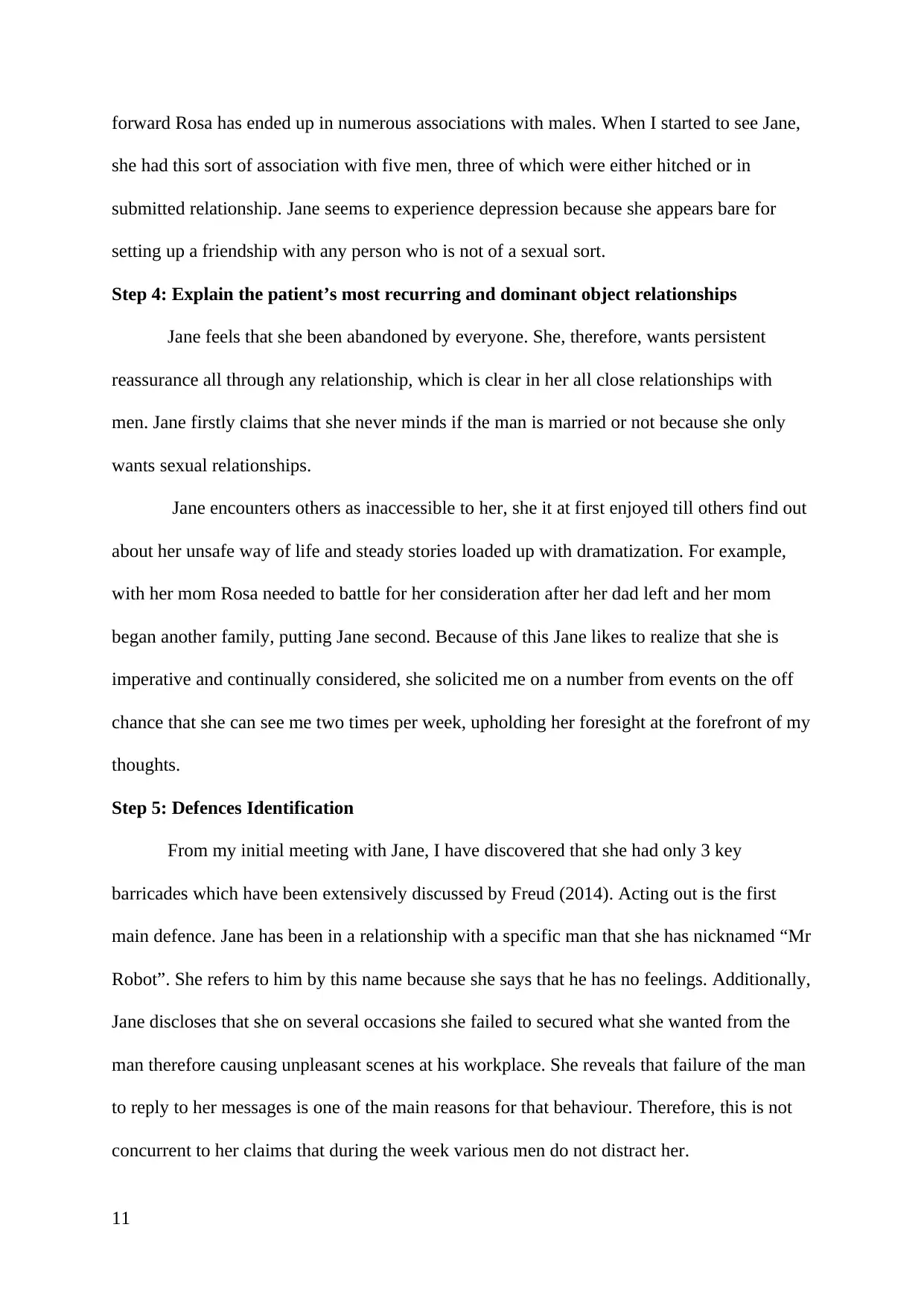
forward Rosa has ended up in numerous associations with males. When I started to see Jane,
she had this sort of association with five men, three of which were either hitched or in
submitted relationship. Jane seems to experience depression because she appears bare for
setting up a friendship with any person who is not of a sexual sort.
Step 4: Explain the patient’s most recurring and dominant object relationships
Jane feels that she been abandoned by everyone. She, therefore, wants persistent
reassurance all through any relationship, which is clear in her all close relationships with
men. Jane firstly claims that she never minds if the man is married or not because she only
wants sexual relationships.
Jane encounters others as inaccessible to her, she it at first enjoyed till others find out
about her unsafe way of life and steady stories loaded up with dramatization. For example,
with her mom Rosa needed to battle for her consideration after her dad left and her mom
began another family, putting Jane second. Because of this Jane likes to realize that she is
imperative and continually considered, she solicited me on a number from events on the off
chance that she can see me two times per week, upholding her foresight at the forefront of my
thoughts.
Step 5: Defences Identification
From my initial meeting with Jane, I have discovered that she had only 3 key
barricades which have been extensively discussed by Freud (2014). Acting out is the first
main defence. Jane has been in a relationship with a specific man that she has nicknamed “Mr
Robot”. She refers to him by this name because she says that he has no feelings. Additionally,
Jane discloses that she on several occasions she failed to secured what she wanted from the
man therefore causing unpleasant scenes at his workplace. She reveals that failure of the man
to reply to her messages is one of the main reasons for that behaviour. Therefore, this is not
concurrent to her claims that during the week various men do not distract her.
11
she had this sort of association with five men, three of which were either hitched or in
submitted relationship. Jane seems to experience depression because she appears bare for
setting up a friendship with any person who is not of a sexual sort.
Step 4: Explain the patient’s most recurring and dominant object relationships
Jane feels that she been abandoned by everyone. She, therefore, wants persistent
reassurance all through any relationship, which is clear in her all close relationships with
men. Jane firstly claims that she never minds if the man is married or not because she only
wants sexual relationships.
Jane encounters others as inaccessible to her, she it at first enjoyed till others find out
about her unsafe way of life and steady stories loaded up with dramatization. For example,
with her mom Rosa needed to battle for her consideration after her dad left and her mom
began another family, putting Jane second. Because of this Jane likes to realize that she is
imperative and continually considered, she solicited me on a number from events on the off
chance that she can see me two times per week, upholding her foresight at the forefront of my
thoughts.
Step 5: Defences Identification
From my initial meeting with Jane, I have discovered that she had only 3 key
barricades which have been extensively discussed by Freud (2014). Acting out is the first
main defence. Jane has been in a relationship with a specific man that she has nicknamed “Mr
Robot”. She refers to him by this name because she says that he has no feelings. Additionally,
Jane discloses that she on several occasions she failed to secured what she wanted from the
man therefore causing unpleasant scenes at his workplace. She reveals that failure of the man
to reply to her messages is one of the main reasons for that behaviour. Therefore, this is not
concurrent to her claims that during the week various men do not distract her.
11
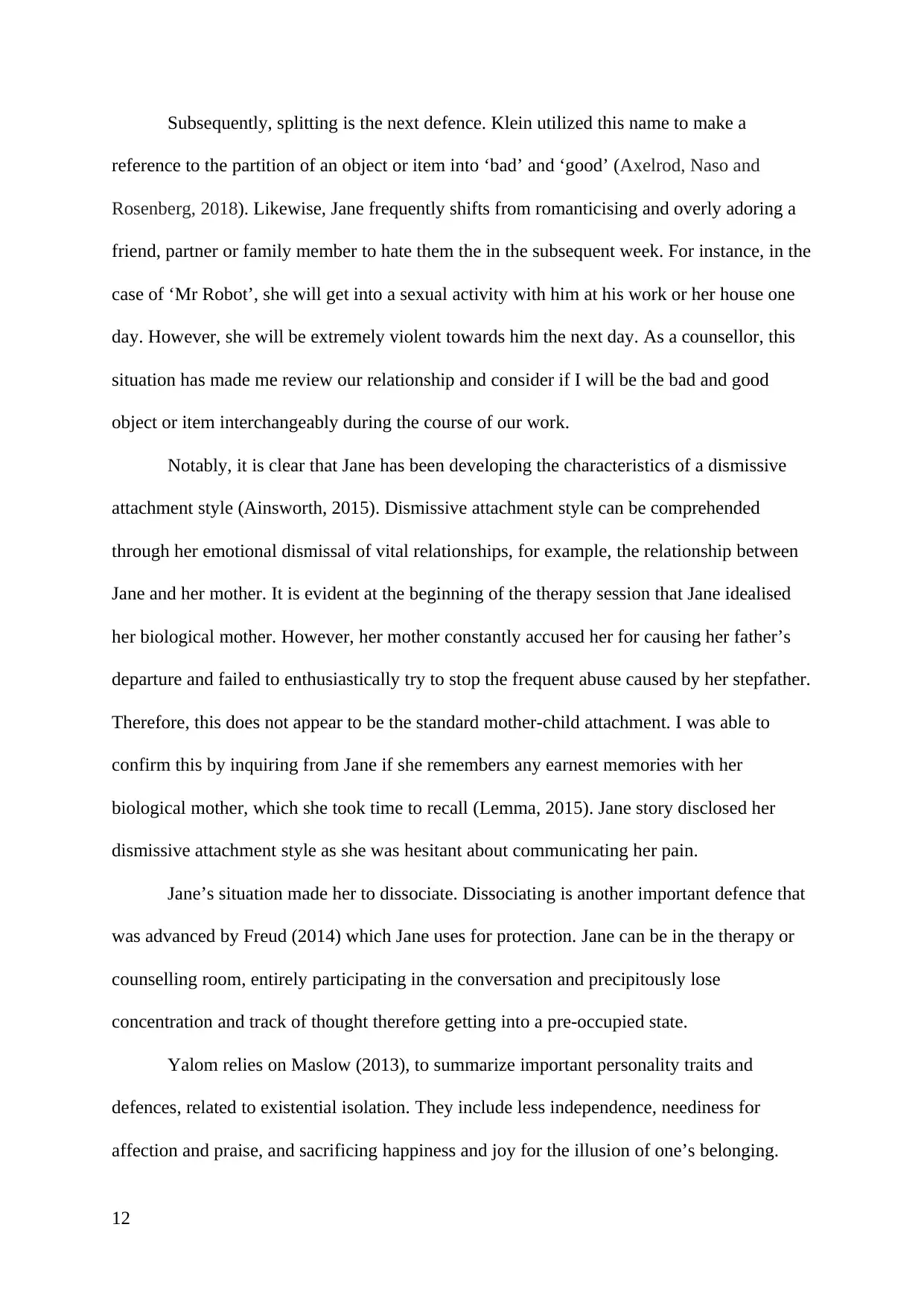
Subsequently, splitting is the next defence. Klein utilized this name to make a
reference to the partition of an object or item into ‘bad’ and ‘good’ (Axelrod, Naso and
Rosenberg, 2018). Likewise, Jane frequently shifts from romanticising and overly adoring a
friend, partner or family member to hate them the in the subsequent week. For instance, in the
case of ‘Mr Robot’, she will get into a sexual activity with him at his work or her house one
day. However, she will be extremely violent towards him the next day. As a counsellor, this
situation has made me review our relationship and consider if I will be the bad and good
object or item interchangeably during the course of our work.
Notably, it is clear that Jane has been developing the characteristics of a dismissive
attachment style (Ainsworth, 2015). Dismissive attachment style can be comprehended
through her emotional dismissal of vital relationships, for example, the relationship between
Jane and her mother. It is evident at the beginning of the therapy session that Jane idealised
her biological mother. However, her mother constantly accused her for causing her father’s
departure and failed to enthusiastically try to stop the frequent abuse caused by her stepfather.
Therefore, this does not appear to be the standard mother-child attachment. I was able to
confirm this by inquiring from Jane if she remembers any earnest memories with her
biological mother, which she took time to recall (Lemma, 2015). Jane story disclosed her
dismissive attachment style as she was hesitant about communicating her pain.
Jane’s situation made her to dissociate. Dissociating is another important defence that
was advanced by Freud (2014) which Jane uses for protection. Jane can be in the therapy or
counselling room, entirely participating in the conversation and precipitously lose
concentration and track of thought therefore getting into a pre-occupied state.
Yalom relies on Maslow (2013), to summarize important personality traits and
defences, related to existential isolation. They include less independence, neediness for
affection and praise, and sacrificing happiness and joy for the illusion of one’s belonging.
12
reference to the partition of an object or item into ‘bad’ and ‘good’ (Axelrod, Naso and
Rosenberg, 2018). Likewise, Jane frequently shifts from romanticising and overly adoring a
friend, partner or family member to hate them the in the subsequent week. For instance, in the
case of ‘Mr Robot’, she will get into a sexual activity with him at his work or her house one
day. However, she will be extremely violent towards him the next day. As a counsellor, this
situation has made me review our relationship and consider if I will be the bad and good
object or item interchangeably during the course of our work.
Notably, it is clear that Jane has been developing the characteristics of a dismissive
attachment style (Ainsworth, 2015). Dismissive attachment style can be comprehended
through her emotional dismissal of vital relationships, for example, the relationship between
Jane and her mother. It is evident at the beginning of the therapy session that Jane idealised
her biological mother. However, her mother constantly accused her for causing her father’s
departure and failed to enthusiastically try to stop the frequent abuse caused by her stepfather.
Therefore, this does not appear to be the standard mother-child attachment. I was able to
confirm this by inquiring from Jane if she remembers any earnest memories with her
biological mother, which she took time to recall (Lemma, 2015). Jane story disclosed her
dismissive attachment style as she was hesitant about communicating her pain.
Jane’s situation made her to dissociate. Dissociating is another important defence that
was advanced by Freud (2014) which Jane uses for protection. Jane can be in the therapy or
counselling room, entirely participating in the conversation and precipitously lose
concentration and track of thought therefore getting into a pre-occupied state.
Yalom relies on Maslow (2013), to summarize important personality traits and
defences, related to existential isolation. They include less independence, neediness for
affection and praise, and sacrificing happiness and joy for the illusion of one’s belonging.
12
⊘ This is a preview!⊘
Do you want full access?
Subscribe today to unlock all pages.

Trusted by 1+ million students worldwide
1 out of 55
Your All-in-One AI-Powered Toolkit for Academic Success.
+13062052269
info@desklib.com
Available 24*7 on WhatsApp / Email
![[object Object]](/_next/static/media/star-bottom.7253800d.svg)
Unlock your academic potential
Copyright © 2020–2025 A2Z Services. All Rights Reserved. Developed and managed by ZUCOL.